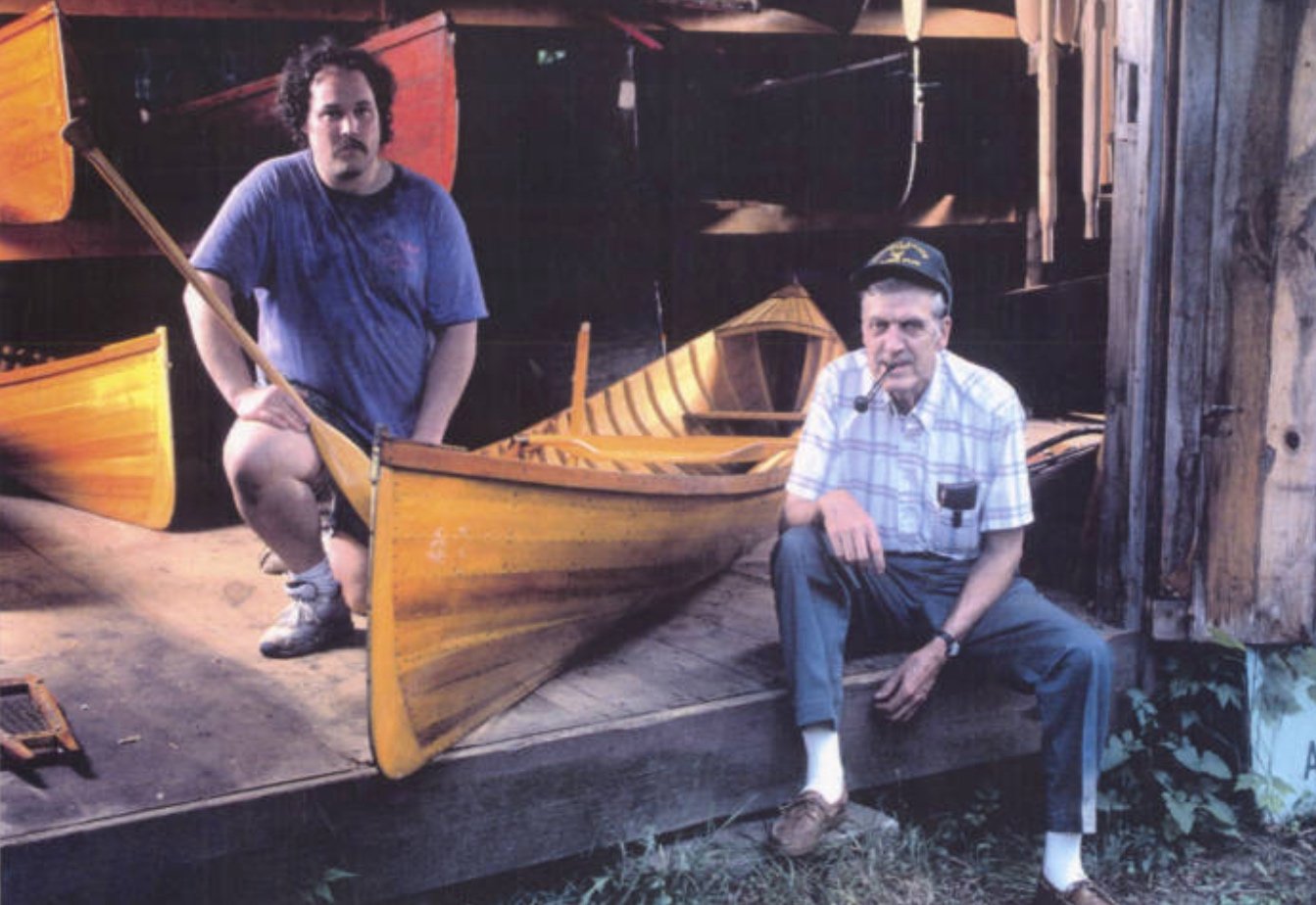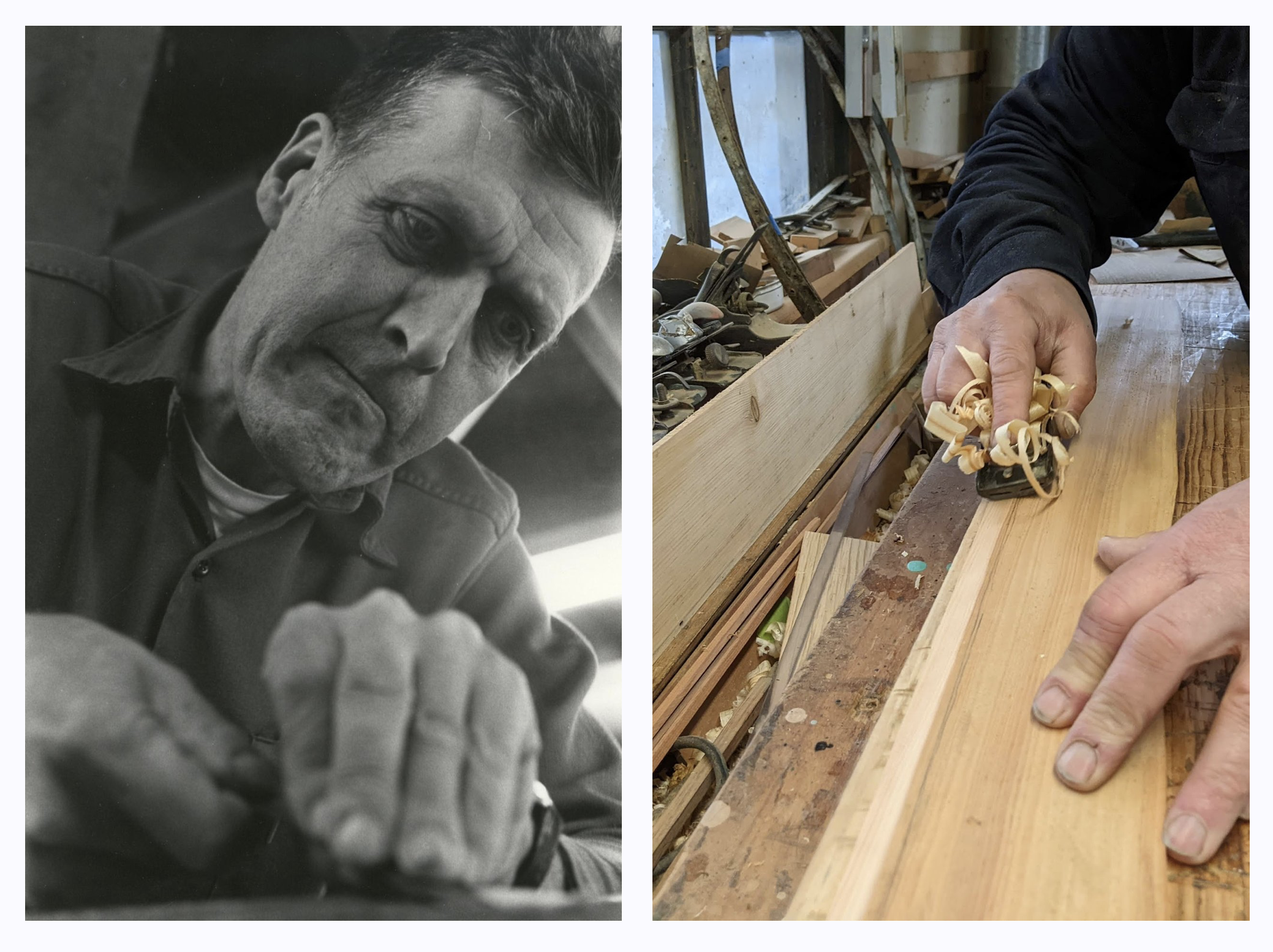SANDING a new waltz feat. Chris Woodward: "THE OLD GUIDEBOAT"
CLICK HERE TO WATCH MUSIC VIDEO!
Guideboat made by Willard Hanmer on display at the Potsdam Public Museum, Potsdam, NY (Used with permission.)
Fiddler Gretchen Koehler visits Chris Woodward at his shop, Woodward Boat Shop, Saranac Lake, NY (Koehler photo)
CHRIS WOODWARD, Guideboat builder, restorer & repairer
I had the pleasure of visiting Woodward Boat Shop, just off Route 3 in Saranac Lake, NY. The smell of wood from sawdust and shavings on the floor brought me memories of trips to the violin shop to have the luthier care for my old violin.
Woodward Boat Shop, Saranac Lake, NY
Chris Woodward carrying a guideboat at Great Camp Sagamore, Raquette Lake, NY. (Koehler photo)
GUIDEBOAT HISTORY
Before I visited the shop, I poured over Chris’s incredibly informative website www.guideboats.com. Those unfamiliar might mistake a guideboat for a canoe, but guideboats are wider, have flat bottoms and are rowed rather than paddled. They move effortlessly and quietly through the water, which makes them stealthy for hunting. They were designed to be as light as possible (60 lbs) to carry over the land strips between waterways, yet be strong enough to hold an amazing 1,000 pounds. The name “guideboat” points to the 19th century when wealthy visitors to the region would hire the locals to guide them on their hunting expeditions. Over the years, folks became less focused on hunting and more focused on the prestige of collecting these handsome wooden boats for museums and personal collections.
Chris Woodward’s mentor, Carl Hathaway, carrying a guideboat. (Photograph courtesy of Adirondack Research Room, Saranac Lake Free Library, Saranac Lake, NY.)
Keeping history alive with a popular event. (Koehler photo)
MENTORS
Chris has worked on hundreds of guideboats over his 30+ year career. As a child, he had wanted to own a guideboat, but since they sold for thousands of dollars, he doubted he’d be able to afford one. In college, he jumped at the opportunity to take a traditional guideboat making class from master builders Carl Hathaway and Ralph Morrow.
Chris is the 4th generation of boatbuilders to own this 1930s boat shop following in the footsteps of Theodore and Willard Hanmer, Ralph Morrow and Carl Hathaway. Chris apprenticed with Carl and eventually bought the shop from him in 1991. As he showed me around, the presence of his predecessors could be seen in both the black and white photographs on display and in the hundreds of tools covering the walls and ceiling that had accumulated over nearly 90 years.
Lining up for the start of the 6oth anniversary of the Willard Hanmer Guideboat Race, Saranac Lake, NY. (Koehler photo)
PICKUP TRUCKS VS. CADILLACS
Chris is the first to tell you he does not consider himself an artist, but rather a craftsman. He said he doesn’t consider the boats works of art or sculpture either, nor does he refer to them with a gender. As his mentor Carl liked to say, they were the "pickup trucks” of the North Country waterways, used to move things like groceries or luggage from here to there. They had a work purpose. Nowadays collectors treat them like Cadillacs. As I listened to Chris, I knew I wanted to write a tune that, like a guideboat, had a purpose and a function. I thought a dance tune, composed for the purpose of dancing, would hit the mark.
“I wanted to write a tune that, like a guideboat, had a purpose and a function.”
Sawdust covers the tools at the Woodward Boat Shop, Saranac Lake, NY. (Koehler photo)
SOUNDS & RHYTHM
I asked Chris to talk about any “sounds and rhythms” in his work. He figured I would ask, and had set up some things for me to film. When he told me he has done a lot of demos around the region and taught classes over the years, I was not at all surprised.
He estimates that 80% of boat building is sanding, calculating that he probably sands the entire boat an astonishing 9 times. I asked him if he found the repetitive motions in his work relaxing or meditative. He paused and asked where the word "tedious" might fit into the scale.
He grabbed a handful of copper tacks, his ball pein hammer and a piece of iron that was about the size of a bar of soap. As he set the tacks and hammered them in, he showed me how the 1,000 tacks were used to cinch together the perfectly angled overlapping planks. This precision is the key ingredient to making the boat watertight without use of adhesives. Chris joked that the tune I was composing would probably be a slow one, since nothing moves very quickly when it comes to working on a guideboat.
“Chris joked that the fiddle tune I was composing would probably be a slow one, since nothing moves very quickly when it comes to working on a guideboat.”
Chris Woodward tacking the planks together to make a watertight seal in an ADK guideboat. (Koehler photo.)
Guideboat made by Ralph Morrow owned by John Homes, Adirondack Rowboats Paddle & Oar. (Koehler photo)
RESTORATION, REPAIR & MAINTENANCE
Since these boats have been in use for over 150 years, Chris spends most of his time restoring, repairing and maintaining old boats. He admits that the work is dirty, dusty and grimy and not the slightest bit glamorous. With his expertise, he has learned to recognize the different builder personal styles from 100 years ago, and is excellent at making seamless repairs on someone else’s boat.
I enjoyed that he recognized the work of other makers. My old violin has suffered many injuries during its 300 year journey from Italy to my hands in America 40 years ago. I can see faint crack lines, but the majority of the repair work is hidden on the inside of the instrument. In essence, if a repair is done well, it is nearly invisible.
My trusted luthier, Thomas Holder, marveled at the repair work and tidy football shaped patching done inside my fiddle. He told me he could see evidence that luthiers had dated their repair work over hundreds of years and Tom even saw one technique that he had not seen in the 20th century.
WORK IS WORK
Chris wishes he was called upon to make more new boats, only having made 20 in these last 30 years. He said that making a brand new boat is clean work. The wood is in mint condition and you have the freedom to make your own choices as you build. But whether starting from scratch or restoring, it is most certainly hard work cutting down pine trees for long knot free planks and digging up spruce stumps for curved ribs. His menor Ralph Morrow used to say, “Work is work, whether you are digging a ditch or building a boat. Work is work.”
“Work is work.”
Woodward Boat Shop, Saranac Lake, NY
WORKING WITH THE PAST
I happened to be embarking on a kitchen renovation project and understood building from scratch vs. the challenges in working within an existing floor plan. Since the latter was such a big part of Chris’s focus, I gave it some thought and landed a musical idea. A few months before, my musical partner, jazz pianist Daniel Kelly, had written a set of chord progressions for an entire fiddle tune, but left the melody up to me. When I sat with his harmonic structure, I was not up for the challenge and took the easier route of composing a brand new tune! But after talking to Chris, I decided to revisit Daniel’s chord progressions with new enthusiasm for this experience. With moments of jazzy ⅞ meter, this trad fiddler had to get in the right “groove” to work in harmony within an existing frame. In stark contrast to the old time tune I’d compose, I wanted to offer a moment for audiences to reflect on the “romantic thoughts” of carrying on a tradition and the reality of hard, tedious work.
Chris Woodward showing how a spruce stump is dug and cut along the grain to create a natural and strong rib. (b/w photo courtesy of Chris Woodward. color photos-Koehler photos)
“In stark contrast to my old time waltz, I also wrote the reel “Work is Work. I wanted to offer a moment for audiences to reflect on the romantic thoughts of carrying on a tradition and the reality of hard, tedious work.”
Photo of Chris Woodward and his mentor, Carl Hathaway. (Photograph courtesy of Adirondack Research Room, Saranac Lake Free Library, Saranac Lake, NY.)
CARL HATHAWAY- master boatbuilder
Chris’s mentor, Carl, passed away in February 2022, just a few months before this interview. Chris told me that Carl liked things done the old way and done well. He also shared that Carl played the violin! Wait, what!!!? I was so delighted to learn that and immediately wondered if he had done his own instrument repairs.
I traveled to Tupper Lake to speak to Carl’s grandson Curtis Switzer and see some boats and try out the family fiddle. He told me that his great grandfather, Albert Hathaway, led a band called “Al’s Radio Gang” that played dances in Franklin County. Though young Carl played the violin, the dance band needed a bass player, so Carl played bass with the group. Curtis said his “papa” had always wanted to learn to play fiddle music on his violin.
“Like a guideboat... every measure is balanced and considered, so the tune can glide forward effortlessly.”
Carl’s father’s fiddle pictured in the family guideboat. Alfred Hathaway’s band “Al’s Radio Gang” performed dances around Franklin County in the mid 1900s. (Koehler photo.)
Chris asked me if I would dedicate the tune for “Fiddling With Traditions” to Carl and I was very happy to oblige. I knew I would follow a strict, traditional form for Carl’s piece and thought it should be a dance to honor his family’s band. An old time waltz was in order.
“Chris asked me if I would dedicate the tune for “Fiddling With Traditions” to his mentor, Carl Hathaway. I knew I would follow a strict, traditional form and thought it should be a dance to honor his family’s band. ”
WATCH THE OFFICIAL MUSIC VIDEO!
LISTENING GUIDE
Like a guideboat...
~This tune follows the rules of fiddle tune construction.
~Every measure is balanced and considered, so the tune can glide forward effortlessly.
~my bowing uses long, sweeping strokes like the long planks of pine with no knots. I sanded down the phrases. The tune is 70% sanding (a guideboat builder joke).
Like a guideboat...
~The passengers facing one direction and the rower facing another, as heard by the different perspectives (ranges) in the B part.
Unlike a guideboat...
~This fiddle tune has only 531 melody notes, yet the boats are held together with 3000 tacks and 1500 small screws. (Hmmm, I wonder what our total is if we add in the piano’s notes to our tally!)
Lastly...
~The tune is lovely, but that’s beside the point!! The tune, like a guideboat, wasn't made for it's beauty, it was made for a specific purpose. A job. A function. This is a waltz. I wrote it for dancing.
~This tune is called "The Old Guideboat" and is dedicated to the memory of Carl Hathaway and those who carry on this tradition.
The working hands of Carl Hathaway (left) and his apprentice Chris Woodward (right). (B&W Photograph courtesy of Adirondack Research Room, Saranac Lake Free Library. Color photograph- Koehler photo)
At Great Camp Sagamore, Raquette Lake, NY enjoying a ride in a guideboat built by Chris Woodward. (L-R Gretchen Koehler, Joel Foisy, Chris Woodward.)
















